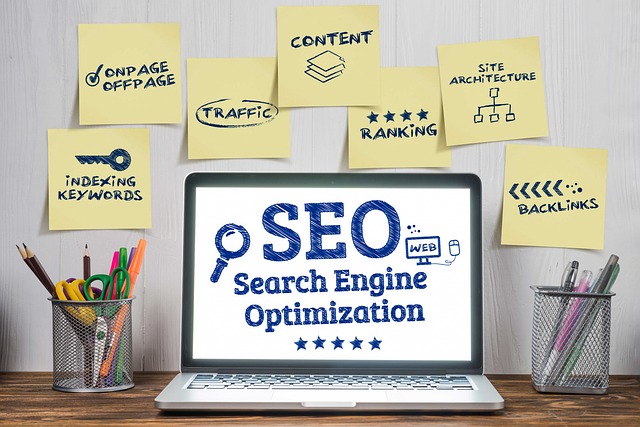In today's digital era, sustainable growth is crucial for business success, requiring integration of environmental responsibility, social equity, and economic viability into core operations. White-Hat SEO Techniques are a powerful tool to promote eco-friendly practices and align with sustainability principles. By focusing on transparent content creation, keyword optimization, and user engagement, businesses can improve search engine rankings, build trust, and capture dedicated online markets. These techniques enhance site authority, reduce energy consumption, and drive organic traffic growth while promoting environmental and social responsibility through KPIs.
In today’s digital landscape, sustainable growth isn’t just an environmental imperative—it’s a competitive business strategy. As consumers increasingly demand eco-friendly products and services online, understanding and implementing effective SEO (Search Engine Optimization) becomes crucial. This article explores how White-Hat SEO Techniques play a pivotal role in promoting environmental awareness and driving sustainable growth. From optimizing content to technical practices and user engagement, discover key strategies to achieve long-term success while contributing to a greener digital presence.
Understanding Sustainable Growth and Its Digital Demand

In today’s digital age, sustainable growth is not just a buzzword but a vital strategy for businesses aiming to thrive in the long term. It involves a holistic approach that prioritizes environmental responsibility, social equity, and economic viability. To achieve this, companies must adapt their online presence and marketing strategies, especially when it comes to search engine optimization (SEO). Understanding sustainable growth means recognizing its digital demand—consumers are increasingly conscious of ethical practices and actively seek out eco-friendly or socially responsible brands.
This shift in consumer behavior presents an opportunity for businesses to harness White-Hat SEO Techniques. By focusing on ethical and transparent content creation, these techniques enable companies to rank higher in search engine results while building trust with their audience. Keywords related to sustainability, such as “eco-friendly products” or “socially responsible practices,” are becoming increasingly relevant, allowing forward-thinking brands to capture a dedicated online market segment.
The Role of White-Hat SEO in Promoting Environmental Awareness

In the pursuit of sustainable growth, businesses are increasingly recognizing the power of White-Hat SEO Techniques as a tool for promoting environmental awareness. This approach focuses on ethical and long-lasting strategies to improve search engine rankings, aligning perfectly with the principles of sustainability. By implementing these white-hat methods, companies can effectively communicate their eco-friendly practices and values to their target audience. For instance, optimizing content with relevant keywords related to sustainability, such as “green initiatives” or “eco-conscious products,” helps potential customers discover businesses committed to environmental preservation.
Moreover, White-Hat SEO encourages the creation of high-quality, informative content that educates consumers about sustainable choices. Blogs, articles, and videos sharing insights on eco-friendly practices can attract organic traffic and foster a sense of responsibility among viewers. This not only boosts online visibility but also contributes to a broader cultural shift towards sustainability, making it a powerful strategy for businesses aiming to leave a positive environmental impact.
Optimizing Website Content for Long-Term Eco-Friendly Results

To optimize website content for long-term eco-friendly results using White-Hat SEO Techniques, focus on creating high-quality, relevant, and engaging content that resonates with your target audience’s sustainable values. Incorporate keywords naturally into headings, meta descriptions, and throughout your copy, ensuring they align with search trends and user intent.
Use industry-specific terms related to sustainability and eco-friendly practices, enhancing your site’s authority in this domain. Regularly update content to reflect the latest green initiatives and technologies, demonstrating your commitment to sustainable growth. Interlink relevant pages within your site to strengthen its information architecture, making it easier for search engines to crawl and understand your content’s value.
Technical SEO Practices for a Greener Online Presence

In the pursuit of sustainable growth, embracing technical SEO practices is paramount for businesses aiming to enhance their online visibility while promoting environmental consciousness. White-Hat SEO Techniques form the bedrock of this approach, emphasizing ethical and sustainable optimization strategies. By ensuring website speed improvements, implementing structured data markup, and enhancing mobile responsiveness, businesses can achieve better search engine rankings and simultaneously reduce energy consumption associated with slower loading times. These practices not only attract eco-conscious users but also contribute to overall website efficiency.
Additionally, optimizing site architecture, improving internal linking structures, and utilizing semantic keywords effectively empower search engines to understand content context better. Such optimizations are key to avoiding penalty risks from search engine algorithms while fostering a user-friendly experience. By integrating these White-Hat SEO Techniques, businesses can foster a greener online presence that aligns with their sustainability goals, ultimately driving long-term success in an increasingly environmentally aware digital landscape.
Leveraging User Engagement and Link Building Strategies

In the realm of White-Hat SEO Techniques, user engagement and link building strategies are powerful tools for fostering sustainable growth. By creating content that captivates and retains users, businesses can elevate their search engine rankings organically. Interactive elements, regular updates, and a user-friendly design encourage visitors to spend more time on the site, reducing bounce rates and signaling to algorithms that the page is valuable.
Link building, another cornerstone of White-Hat SEO, involves acquiring high-quality backlinks from reputable sources. This can be achieved through strategic partnerships, guest blogging, and creating shareable content. These efforts not only drive traffic but also enhance the site’s authority and trustworthiness in the eyes of search engines. A diverse backlink profile, comprising links from diverse domains, reinforces the site’s relevance and credibility on relevant topics.
Measuring Success: Tracking KPIs for Sustainable SEO Performance

Measuring success is a critical aspect of any SEO strategy, especially when fostering sustainable growth. Instead of relying solely on traditional metrics like keyword rankings, sustainable SEO performance should be tracked using key performance indicators (KPIs) that align with environmental and social responsibility. These KPIs could include organic traffic growth rates, bounce rates, average session duration, and pageviews per visit, which offer insights into user engagement and satisfaction. By utilizing White-Hat SEO Techniques, such as ethical link building, high-quality content creation, and mobile optimization, brands can ensure their online presence positively impacts both search engine rankings and real-world sustainability metrics.
Regularly monitoring these KPIs allows businesses to make data-driven decisions, fine-tune their strategies, and adapt to evolving user preferences and search engine algorithms. This proactive approach enables companies to foster long-term growth while promoting eco-friendly practices and social responsibility, ensuring their SEO efforts contribute to a more sustainable digital future.
